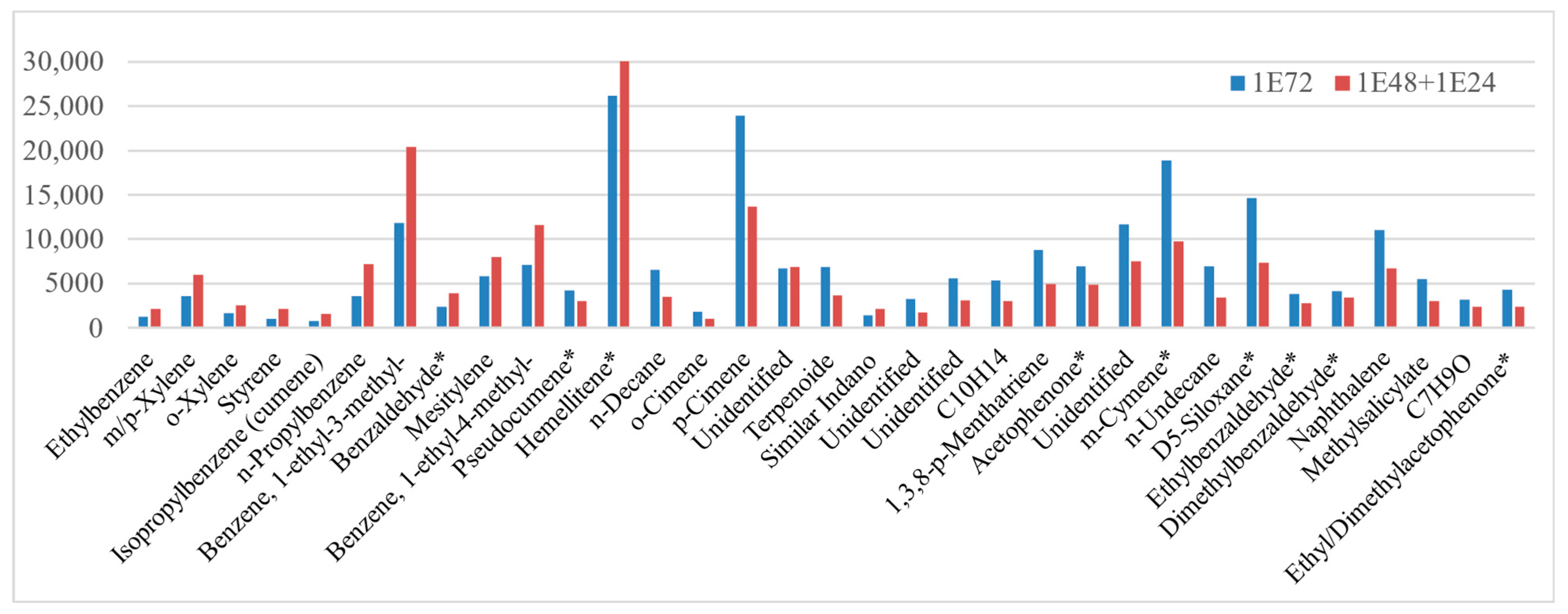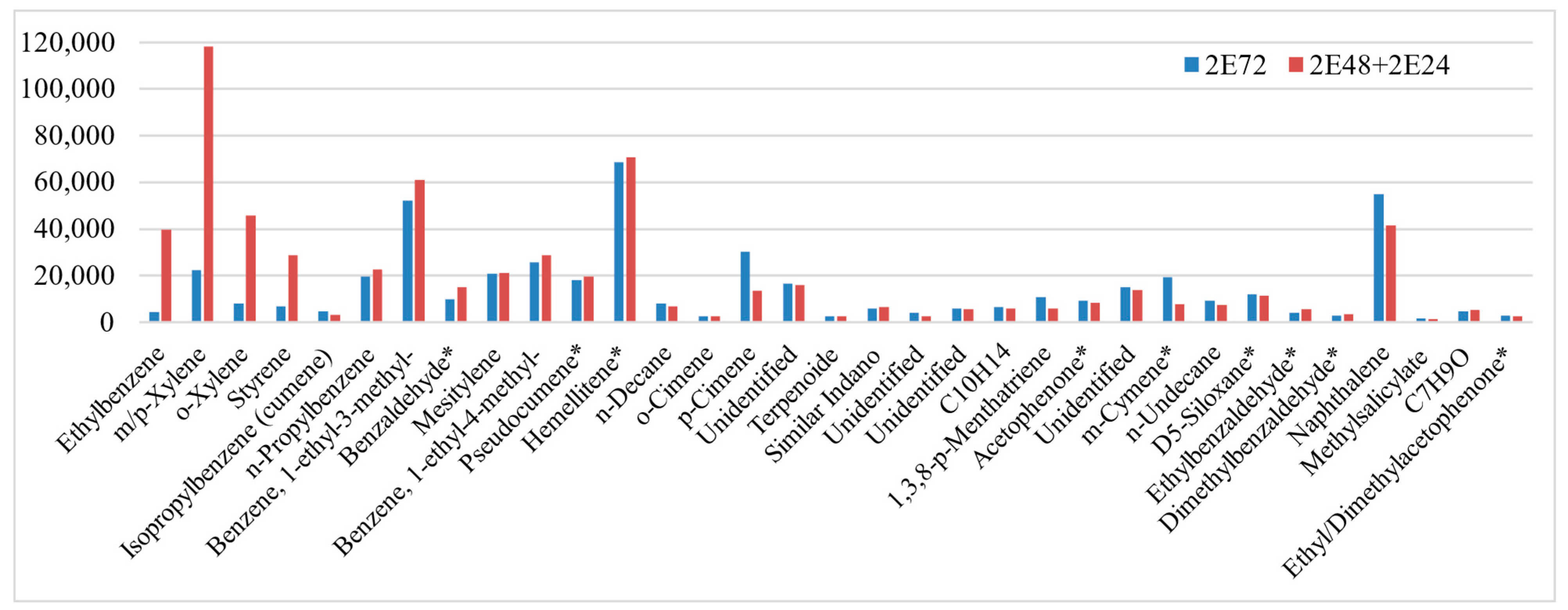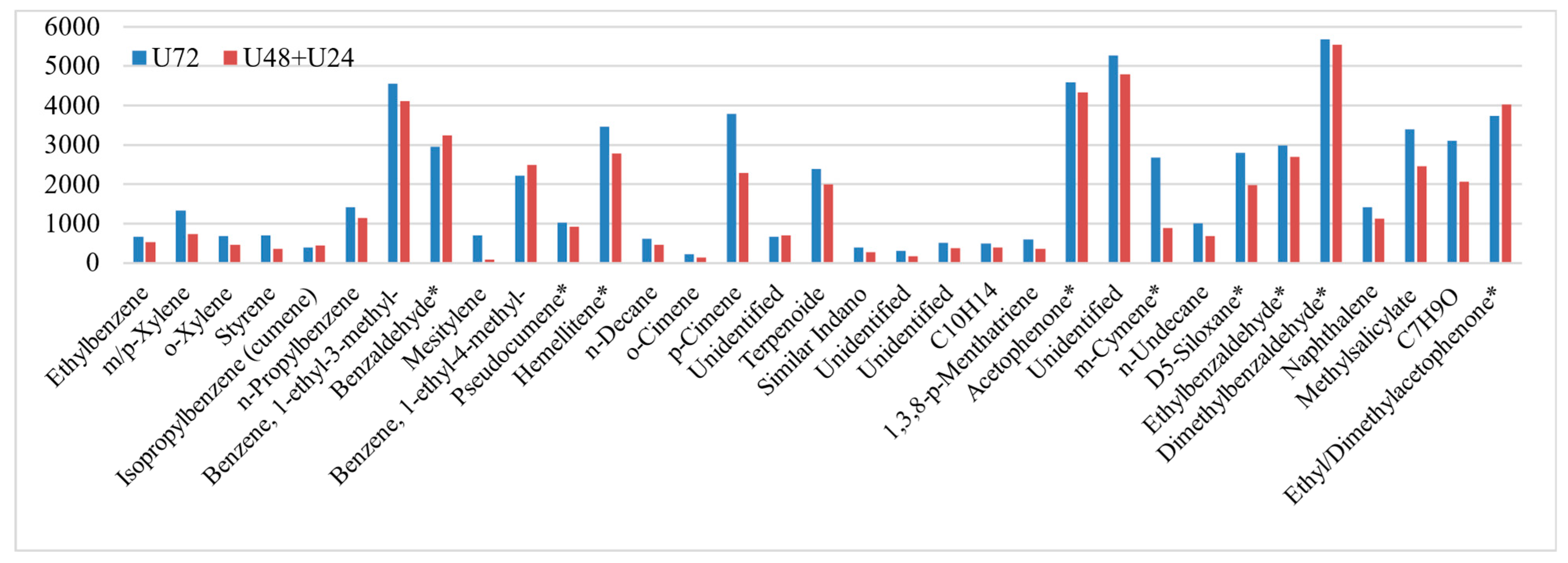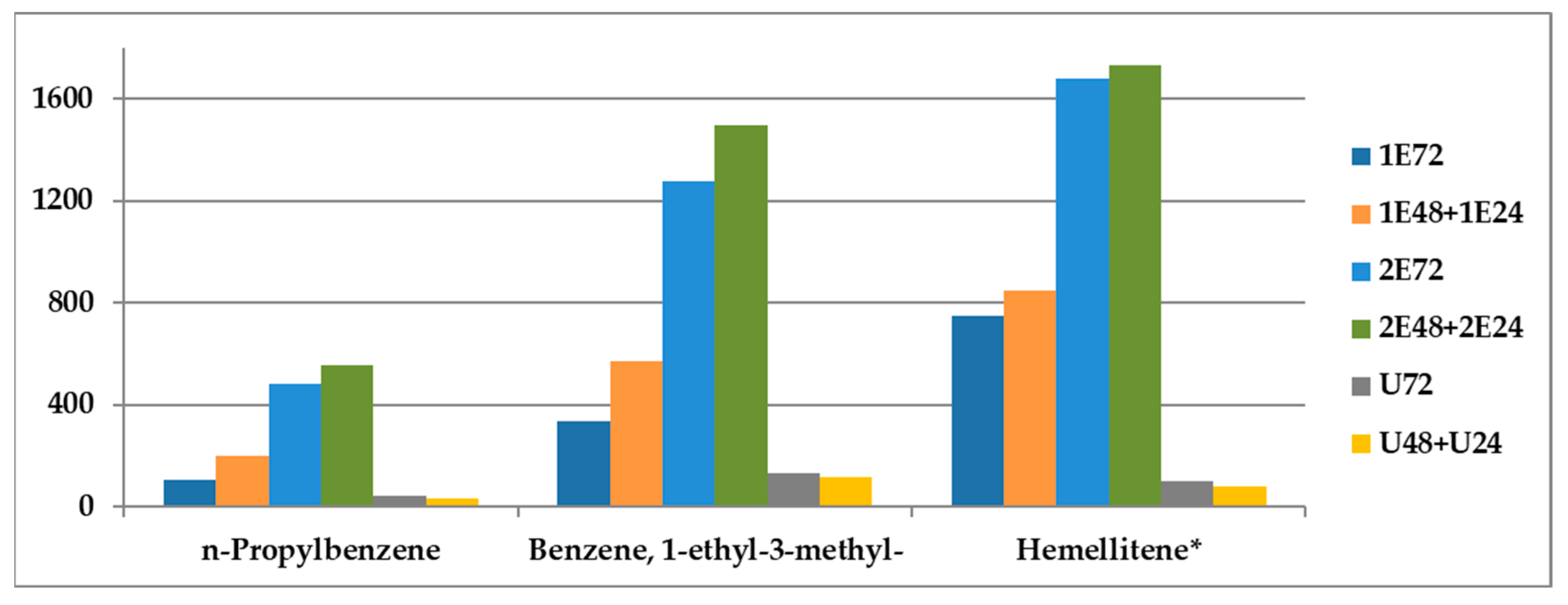Critical Insights into Untargeted GC-HRMS Analysis: Exploring Volatile Organic Compounds in Italian Ambient Air
Abstract
1. Introduction
2. Materials and Methods
2.1. Standard Solutions and Solvents
2.2. Sampling
2.3. Extraction and Clean-Up
2.4. Instrumental Analysis
2.5. Deconvolution and Library Search
2.5.1. Deconvolution Plugin—Settings
2.5.2. Unknown Screening—Settings
2.6. Selection of Major Components for Identification and Quantification
2.7. Semi-Quantitative Analysis
3. Results
3.1. Major Components Identified
3.2. Semi-Quantitative Analysis
4. Discussion
4.1. Selection of Sampling Sites, Sampler and Sampling
4.2. Feasibility, Prospects and Limitations of Analysis of Full-Scan High-Resolution Electron Ionization Accurate Mass Chromatograms
4.3. Optimization of Deconvolution Methods
4.4. Selection of Major Components for Identification and Quantification
4.5. Structure Elucidation of Selected Major Components—One by One
- Isomers of C8H10.
- Isomers of C9H12.
- Artifact.
- Isomers of C10H14.
- The alkanes n-Decane at RT 8.21 min (C10H22) and n-Undecane at RT 9.85 (C11H24) have been uniquely identified, although the software recognition suggested other compounds.
- Two peaks not recognized by the TraceFinder and identified manually as styrene and o-xylene were also included in Table 1 (peak N°2 and 3).
- The C5H7O-X structure at RT = 12.52 represents a true unknown and further studies are needed to reveal its structure.
- -
- C10 alkyl aromatic hydrocarbons
- -
- Terpenoids
- -
- Substituted benzenes (for example the C8 group)
- -
- Oxygenated compounds.
4.6. Semi-Quantitative Analysis
4.7. Chemical Nature, Variety, Contribution and Significance of Major Components of Ambient Air in Italy
4.8. Chemical Nature, Variety, Contribution, and Significance of Major Components in Ambient Air in Italy
- Benzene, 1-ethyl-3-methyl- (CAS no. 620-14-4): A key component of aromatic chemical classes and surrogate kerosene fuels [30]. According to the classification provided by companies to the European Chemicals Agency [31], it is potentially fatal if swallowed and enters airways, toxic to aquatic life with long-lasting effects, flammable, and capable of causing drowsiness or dizziness.
- p-Cymene (CAS no. 99-87-6): Widely found in nature, particularly in the essential oils of various aromatic plant species [32]. It is used in products such as biocides, cleaning agents, polishes, waxes, perfumes, and personal care items [33]. According to the harmonised classification and labelling set by the EU, the substance is classified as potentially fatal if swallowed and enters airways, toxic if inhaled, toxic to aquatic life with long-lasting effects, and is a flammable liquid and vapour (EU Regulation 2021/849). Furthermore, according to the classification provided by companies to the ECHA, this substance is suspected of impairing fertility or harming unborn children, it causes eye and skin irritation, and it can potentially cause respiratory irritation [33].
- Naphthalene (CAS no. 91-20-3): A polycyclic aromatic hydrocarbon and common air pollutant originating from industries, biomass burning, and fuel combustion [34]. According to the harmonised classification and labelling set by the EU, the substance is very toxic to aquatic life with long lasting effects, harmful if swallowed, and a suspected carcinogen (EU Regulation 2018/669) [35].
- Hemellitene (CAS no. 526-73-8): An aromatic VOC emitted from motor vehicle exhaust and solvent evaporation [36]. According to the classification provided by companies to ECHA this substance is flammable, causes skin and eye irritation and may be fatal if it enters airways. It is included in the EU list of ozone precursor substances (Directive 2008/50/EC and Directive UE 2024/2881 on ambient air quality) [37].
5. Conclusions
Supplementary Materials
Author Contributions
Funding
Data Availability Statement
Acknowledgments
Conflicts of Interest
References
- Aretaki, M.A.; Desmet, J.; Viana, M.; van Drooge, B.L. Comprehensive methodology for semi-volatile organic compound determination in ambient air with emphasis on polycyclic aromatic hydrocarbons analysis by GC–MS/MS. J. Chromatogr. A 2024, 1730, 465086. [Google Scholar] [CrossRef] [PubMed]
- Vallecillos, L.; Riu, J.; Marcé, R.M.; Borrull, F. Air monitoring with passive samplers for volatile organic compounds in atmospheres close to petrochemical industrial areas. The case study of Tarragona (2019–2021). Atmos. Pollut. Res. 2024, 15, 101986. [Google Scholar] [CrossRef]
- Ambade, B.; Kumar, A.; Sahu, L.K. Characterization and health risk assessment of particulate bound polycyclic aromatic hydrocarbons (PAHs) in indoor and outdoor atmosphere of Central East India. Environ. Sci. Pollut. Res. 2021, 28, 56269–56280. [Google Scholar] [CrossRef] [PubMed]
- Iakovides, M.; Apostolaki, M.; Stephanou, E.G. PAHs, PCBs and organochlorine pesticides in the atmosphere of Eastern Mediterranean: Investigation of their occurrence, sources and gas-particle partitioning in relation to air mass transport pathways. Atmos. Environ. 2021, 244, 117931. [Google Scholar] [CrossRef]
- Nagar, N.; Bartrons, M.; Brucet, S.; Davidson, T.A.; Jeppesen, E.; Grimalt, J.O. Seabird-mediated transport of organohalogen compounds to remote sites (North West Greenland polynya). Sci. Total Environ. 2022, 827, 154219. [Google Scholar] [CrossRef]
- Smith, A.P.; Lindeque, J.Z.; van der Walt, M.M. Untargeted Metabolomics Reveals the Potential Antidepressant Activity of a Novel Adenosine Receptor Antagonist. Molecules 2022, 27, 2094. [Google Scholar] [CrossRef] [PubMed]
- Jacob, P.; Wang, R.; Ching, C.; Helbling, D.E. Evaluation, optimization, and application of three independent suspect screening workflows for the characterization of PFASs in water. Environ. Sci. Process. Impacts 2021, 23, 1554–1565. [Google Scholar] [CrossRef] [PubMed]
- Ji, X.; Ji, W.; Ding, L. Untargeted GC-MS metabolomics combined with multivariate statistical analysis as an effective method for discriminating the geographical origin of shrimp paste. Food Anal. Methods 2023, 17, 200–206. [Google Scholar] [CrossRef]
- Beer, F.; Weinert, C.H.; Wellmann, J.; Hillebrand, S.; Ley, J.P.; Soukup, S.T.; Kulling, S.E. Comprehensive metabolome characterization of leaves, internodes, and aerial roots of Vanilla planifolia by untargeted LC–MS and GC × GC–MS. Phytochem. Anal. 2024, 36, 30–51. [Google Scholar] [CrossRef] [PubMed]
- Du, Q.Y.; He, M.; Gao, X.; Yu, X.; Zhang, J.N.; Shi, J.; Zhang, F.; Lu, Y.Y.; Wang, H.Q.; Yu, Y.J.; et al. Geographical discrimination of Flos Trollii by GC-MS and UHPLC-HRMS-based untargeted metabolomics combined with chemometrics. J. Pharm. Biomed. Anal. 2023, 234, 115550. [Google Scholar] [CrossRef]
- Fu, Y.; Wu, Z.; Wei, Y.; Wang, X.; Zou, J.; Xiao, L.; Fan, W.; Yang, H.; Liao, L. Untargeted and targeted metabolomics analysis of CO poisoning and mechanical asphyxia postmortem interval biomarkers in rat and human plasma by GC[sbnd]MS. J. Pharm. Biomed. Anal. 2024, 251, 116443. [Google Scholar] [CrossRef]
- Warner, N.A.; Nikiforov, V.; Krogseth, I.S.; Bjørneby, S.M.; Kierkegaard, A.; Bohlin-Nizzetto, P. Reducing sampling artifacts in active air sampling methodology for remote monitoring and atmospheric fate assessment of cyclic volatile methylsiloxanes. Chemosphere 2020, 255, 126967. [Google Scholar] [CrossRef]
- Khodadadi, M.; Pourfarzam, M. A Review of Strategies for Untargeted Urinary Metabolomic Analysis Using Gas Chromatography–Mass Spectrometry. Metabolomics 2020, 16, 66. [Google Scholar] [CrossRef]
- Hollender, J.; van Bavel, B.; Dulio, V.; Farmen, E.; Furtmann, K.; Koschorreck, J.; Kunkel, U.; Krauss, M.; Munthe, J.; Schlabach, M.; et al. High Resolution Mass Spectrometry-Based Non-Target Screening Can Support Regulatory Environmental Monitoring and Chemicals Management. Environ. Sci. Eur. 2019, 31, 42. [Google Scholar] [CrossRef]
- AccuStandards Method 502.2—Volatile Organic Compounds. Available online: https://www.accustandard.com/prod0006217.html (accessed on 19 January 2025).
- U.S. Environmental Protection Agency. EPA TO-17: Determination of Volatile Organic Compounds in Ambient Air Using Active Sampling onto Sorbent Tubes; Center for Environmental Research Information, Office of Research and Development: Cincinnati, OH, USA, 1999. [Google Scholar]
- Italian National Standardization Body (UNI). UNI EN ISO 16000-5:2007; Indoor Air—Part 5: Sampling Strategy for Volatile Organic Compounds (VOC); UNI: Milan, Italy, 2007. [Google Scholar]
- U.S. EPA Methyl Salicylate. Available online: https://ordspub.epa.gov/ords/pesticides/f?p=CHEMICALSEARCH:3::::1,3,31,7,12,25:P3_XCHEMICAL_ID:3165 (accessed on 27 May 2022).
- PubChem Methyl Salicylate. Available online: https://pubchem.ncbi.nlm.nih.gov/compound/Methyl-salicylate#section=Uses (accessed on 19 January 2025).
- U.S. EPA Methylparaben. Available online: https://comptox.epa.gov/dashboard/chemical/details/DTXSID4022529 (accessed on 27 May 2022).
- PubChem Methylparaben. Available online: https://pubchem.ncbi.nlm.nih.gov/compound/Methylparaben#section=Uses (accessed on 27 May 2022).
- PubChem Eucalyptol. Available online: https://pubchem.ncbi.nlm.nih.gov/compound/2758#section=Drug-and-Medication-Information (accessed on 29 May 2022).
- Wagrowski, D.M.; Hites, R.A. Polycyclic Aromatic Hydrocarbon Accumulation in Urban, Suburban, and Rural Vegetation. Environ. Sci. Technol. 1997, 31, 279–282. [Google Scholar] [CrossRef]
- Llusia, J.; Peñuelas, J.; Seco, R.; Filella, I. Seasonal Changes in the Daily Emission Rates of Terpenes by Quercus Ilex and the Atmospheric Concentrations of Terpenes in the Natural Park of Montseny, NE Spain. J. Atmos. Chem. 2012, 69, 215–230. [Google Scholar] [CrossRef]
- Petr, P.; Soukupová, A. Terpenes in forest Air—Health benefit and healing potential. Acta Salus Vitae 2016, 4, 61–69. [Google Scholar]
- Aktypis, A.; Sippial, D.J.; Vasilakopoulou, C.N.; Matrali, A.; Kaltsonoudis, C.; Simonati, A.; Paglione, M.; Rinaldi, M.; Decesari, S.; Pandis, S.N. Formation and Chemical Evolution of Secondary Organic Aerosol in Two Different Environments: A Dual-Chamber Study. Atmos. Chem. Phys. 2024, 24, 13769–13791. [Google Scholar] [CrossRef]
- Langat, F.K.; Kibet, J.K.; Okanga, F.I.; Adongo, J.O. Organic Contaminants in the Groundwater of the Kerio Valley Water Basin, Baringo County, Kenya. Eur. J. Chem. 2023, 14, 337–347. [Google Scholar] [CrossRef]
- Zhao, H.; Wang, S.; Sun, J.; Zhang, Y.; Tang, Y. OH-Initiated Degradation of 1,2,3-Trimethylbenzene in the Atmosphere and Wastewater: Mechanisms, Kinetics, and Ecotoxicity. Sci. Total Environ. 2023, 857, 159534. [Google Scholar] [CrossRef] [PubMed]
- Cairoli, M.; van den Doel, A.; Postma, B.; Offermans, T.; Zemmelink, H.; Stroomberg, G.; Buydens, L.; van Kollenburg, G.; Jansen, J. Monitoring Pollution Pathways in River Water by Predictive Path Modelling Using Untargeted GC-MS Measurements. NPJ Clean. Water. 2023, 6, 48. [Google Scholar] [CrossRef]
- Wang, Q.; Yang, M.; Wang, J.; Yang, J.; Zhao, L.; Li, W.; Wang, C.; Lu, T.; Li, Y. Towards a predictive kinetic model of 3-ethyltoluene: Evidence concerning fuel-specific intermediates in the flow reactor pyrolysis with insights into model implications. Proc. Combust. Inst. 2023, 39, 179–188. [Google Scholar] [CrossRef]
- ECHA 3-Ethyltoluene. Available online: https://echa.europa.eu/it/substance-information/-/substanceinfo/100.009.662 (accessed on 23 December 2024).
- Balahbib, A.; El Omari, N.; Hachlafi, N.E.; Lakhdar, F.; El Menyiy, N.; Salhi, N.; Mrabti, H.N.; Bakrim, S.; Zengin, G.; Bouyahya, A. Health beneficial and pharmacological properties of p-cymene. Food Chem. Toxicol. 2021, 153, 112259. [Google Scholar] [CrossRef] [PubMed]
- ECHA p-Cymene. Available online: https://echa.europa.eu/it/substance-information/-/substanceinfo/100.002.542 (accessed on 23 December 2024).
- Jia, C.; Batterman, S. A Critical Review of Naphthalene Sources and Exposures Relevant to Indoor and Outdoor Air. Int. J. Environ. Res. Public Health 2010, 7, 2903–2939. [Google Scholar] [CrossRef] [PubMed]
- ECHA Naphthalene. Available online: https://echa.europa.eu/it/substance-information/-/substanceinfo/100.009.662 (accessed on 23 December 2024).
- Luo, H.; Jia, L.; Wan, Q.; An, T.; Wang, Y. Role of liquid water in the formation of O3 and SOA particles from 1,2,3-trimethylbenzene. Atmos. Environ. 2019, 217, 116955. [Google Scholar] [CrossRef]
- ECHA 1,2,3-Trimethylbenzene. Available online: https://echa.europa.eu/it/substance-information/-/substanceinfo/100.007.633 (accessed on 23 December 2024).





| N° | Best Software Match | RT (min) m/z | Final Assignment | Formula | RI Calculated |
|---|---|---|---|---|---|
| 1 | Ethylbenzene | 5.86 91.05 | Ethylbenzene | C8H10 | 854 |
| 2 | Benzene, 1,3-dimethyl- | 6.03 91.05 | m/p-Xylene | C8H10 | 865 |
| 3 | NOT found | 6.42 | o-Xylene manually identified | C8H10 | 889 |
| 4 | NOT found | 6.41 | Styrene Manually identified | C8H8 | 888 |
| 5 | Cyclopentane, 1,1,3,4-tetramethyl-, trans-; Cyclonone-1,2,6-triene; Benzene, (1-methylethyl)- | 6.93 105.07 | iso-Propylbenzene (cumene) | C9H12 | 920 |
| 6 | Benzene, 3-pentenyl-; Benzene, propyl- | 7.45 91.05 | n-Propylbenzene | C9H12 | 952 |
| 7 | Benzene, 1-ethyl-2-methyl- | 7.59 105.07 | Benzene, 1-ethyl-3-methyl- | C9H12 | 960 |
| 8 | 1,5-Hexadiene, 3,3,4,4-tetrafluoro-; 1-Triazene, 3,3-dimethyl-1-phenyl- | 7.60 77.04 | ARTIFACT | ARTIFACT | 961 |
| 9 | 3-Buten-1-one, 2,2-dimethyl-1-phenyl-; Ethanol, 1-methoxy-, benzoate; Idratropic acid, nonyl ester; (3-Methylphenyl) methanol, 1-methylpropyl ether | 7.61 105.03 | Benzaldehyde * | C7H5O-X | 962 |
| 10 | @peak | 7.60 79.05 | ARTIFACT | ARTIFACT | 961 |
| 11 | Benzene, 1,2,3-trimethyl- | 7.74 105.07 | Mesitylene | C9H12 | 970 |
| 12 | Benzene, 1,2,3-trimethyl- | 7.64 105.07 | Benzene, 1-ethyl-4-methyl- | C9H12 | 963 |
| 13 | Mesitylene | 7.75 105.07 | Benzene, 1-ethyl-2-methyl- | C9H12 | 970 |
| 14 | Benzene, 1-ethyl-2-methyl-; 7-octene-1,2-diol; 2-Pentene, 4,4′-oxybis- | 7.89 105.07 | Pseudocumene * | C9H12 | 979 |
| 15 | Pentane, 2,3,4-trimethyl-; Mesitylene; 2,4-Dodecadienal, (E, E) - | 8.17 105.07 | Hemellitene * | C9H12 | 996 |
| 16 | Carbonic acid, dodecyl vinyl ester; Oxalic acid, 2-ethylhexyl hexyl ester | 8.21 57.07 | n-Decane | C10H22 | 998 |
| 17 | o-Cimene | 8.58 119.09 | o-Cymene | C10H14 | 1021 |
| 18 | o-Cimene | 8.67 119.09 | p-Cymene | C10H14 | 1027 |
| 19 | Benzene, (1-methylethyl) -; 1-Pentene, 3-ethyl-3-methyl- | 8.63 105.07 | Unidentified | C10H14 | 1024 |
| 20 | Eucalyptol | 8.80 93.07 | Terpenoid | C10H18O | 1035 |
| 21 | Indano | 8.86 117.07 | Similar Indano | C9H10 | 1039 |
| 22 | Benzene, 1,3-dimethyl-; Benzene, 1-methyl-2-propyl-; 1-Methyl-3-butenyl 3-methyl-3-hydroxybutyl ether; Sulphurous acid, 2-ethylhexyl isohexyl ester | 9.09 105.07 | Unidentified | C10H14 | 1053 |
| 23 | Propanetrione, diphenyl-; Acetohydrazide, 2-cyano-N2- [4- (4-methylbenzyloxy) benzylideno] -; 1-hexene, 3-methyl-6-phenyl-4- (1-phenylethoxy) - | 9.18 105.07 | Unidentified | C10H14 | 1058 |
| 24 | Fenetilamine, N-benzil-α-metil-; p-Menta-1,5,8-triene; 4,6-Decadiine; 2-Pirrolidineacetic acido | 9.18 91.05 | n-Butylbenzene * Peak mix | C10H14 | 1058 |
| 25 | N, N-Diethyl-2-aminoethanol, O-acetyl; 1,2-Benzenediol, o- (2,2,3,3,4,4,4-heptafluorobutyryl) -o ‘- (4-methylbenzoyl) -; Benzene, 1- (1,5-dimethylhexyl) -4-methyl- | 9.20 119.09 | 1,3,8-p-Menthatriene | C10H14 | 1060 |
| 26 | Ethanone, 2-(acetyloxy)-1-phenyl-; Benzeneacetic acid, α-oxo-, methyl ester | 9.35 105.03 | Acetophenone * | C7H5O-X | 1069 |
| 27 | Benzene, 1-methyl-4-propyl- | 9.34 105.07 | Unidentified | C10H14 | 1068 |
| 28 | o-Cimene | 9.65 119.09 | m-Cymene * | C10H14 | 1088 |
| 29 | Carbonic acid, nonyl vinyl ester | 9.85 57.07 | n-Undecane | C11H24 | 1100 |
| 30 | Octopamine, 3TMS derivative | 10.31 73.05 | D5-Siloxane * | C10H30O5Si5 | 1130 |
| 31 | @peak | 10.91 105.07 | Ethylbenzaldehyde * | C9H10O | 1169 |
| 32 | Benzaldehyde, 4-ethyl- | 11.18 133.06 | Dimethylbenzaldehyde * | C9H10O | 1186 |
| 33 | Naphthalene | 11.33 128.06 | Naphthalene | C10H8 | 1196 |
| 34 | Benzoic acid, 2- (1-methylpropyl) oxi-, methyl ester | 11.37 120.02 | Methylsalicylate LITERATURE | C8H8O2 | 1199 |
| 35 | 1,2-Benzenediol, O-(4-ethylbenzoyl)-O’-methoxycarbonyl- | 12.36 133.06 | Ethyl/Dimethylacetophenone * LITERATURE | C10H12O | 1267 |
| 36 | (1R,2R,3S,5R)-(-)-2,3-Pinanediol | 12.52 83.05 | C7H9O ion LITERATURE | C5H7O-X | 1278 |
| 37 | 4-Ethylbenzoic acid, 2-methylphenyl ester | 12.68 133.06 | Ethyl/Dimethylacetophenone * | C10H12O | 1289 |
Disclaimer/Publisher’s Note: The statements, opinions and data contained in all publications are solely those of the individual author(s) and contributor(s) and not of MDPI and/or the editor(s). MDPI and/or the editor(s) disclaim responsibility for any injury to people or property resulting from any ideas, methods, instructions or products referred to in the content. |
© 2025 by the authors. Licensee MDPI, Basel, Switzerland. This article is an open access article distributed under the terms and conditions of the Creative Commons Attribution (CC BY) license (https://creativecommons.org/licenses/by/4.0/).
Share and Cite
Cerasa, M.; Balducci, C.; Giannelli Moneta, B.; Santoro, S.; Perilli, M.; Nikiforov, V. Critical Insights into Untargeted GC-HRMS Analysis: Exploring Volatile Organic Compounds in Italian Ambient Air. Separations 2025, 12, 35. https://doi.org/10.3390/separations12020035
Cerasa M, Balducci C, Giannelli Moneta B, Santoro S, Perilli M, Nikiforov V. Critical Insights into Untargeted GC-HRMS Analysis: Exploring Volatile Organic Compounds in Italian Ambient Air. Separations. 2025; 12(2):35. https://doi.org/10.3390/separations12020035
Chicago/Turabian StyleCerasa, Marina, Catia Balducci, Benedetta Giannelli Moneta, Serena Santoro, Mattia Perilli, and Vladimir Nikiforov. 2025. "Critical Insights into Untargeted GC-HRMS Analysis: Exploring Volatile Organic Compounds in Italian Ambient Air" Separations 12, no. 2: 35. https://doi.org/10.3390/separations12020035
APA StyleCerasa, M., Balducci, C., Giannelli Moneta, B., Santoro, S., Perilli, M., & Nikiforov, V. (2025). Critical Insights into Untargeted GC-HRMS Analysis: Exploring Volatile Organic Compounds in Italian Ambient Air. Separations, 12(2), 35. https://doi.org/10.3390/separations12020035





